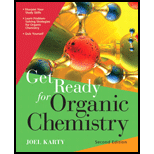
Concept explainers
Interpretation:
It is to be determined in which of the two solvents, dimethyl sulfoxide or ethanol, the given reaction will proceed faster via an
Concept introduction:
An
An
Want to see the full answer?
Check out a sample textbook solution
Chapter 9 Solutions
Get Ready for Organic Chemistry
- Which mechanism is going to predominate under these conditions? A SN1 В SN2 HCI HO or C E1 D E2arrow_forwardDraw a plausible mechanism for the reaction shown below. Determine the major product and provide explanations for each step in the mechanism. H3C. NaBH4 →A LİAIH4 →Barrow_forwardWhich mechanism is going to predominate under these conditions? .CI A SN1 B SN2 HCI HO or E1 D E2 В O D O O Oarrow_forward
- Can you provide a full reaction mechanism for this reaction? Bn is benzyl azide.arrow_forwardA carbamate can be prepared by treating an isocyanate with an alcohol, as shown here. This type of reaction is used to synthesize polyurethanes- polymers that have a wide variety of industrial applications, such as surface sealants, high-performance adhesives, and synthetic fibers. Propose a mechanism for this transformation. R'—ОН R. `N=C=0 R. OR' An isocyanate A carbamate (Substituted urethane) O=Carrow_forwardGive two possible [1,2]-rearrangement products where an alkyl group migrates in the following compound. Motivate also which of the two products will be formed preferentiallyarrow_forward
- Rank the nucleophiles in following group in order of increasing nucleophilicity. H2O, −OH, CH3CO2-arrow_forwardFor each reaction, draw the complete mechanism and the major organic product. (Recall that each of these reactions is expected to have a low yield.) (а) HC=CH H,SO4 H20 (b) (c) D3PO4 ? ? H,SO4 → ? H20 HC=CH D20arrow_forwardDescribe the predominant mechanism( SN1, E1, SN2, E2) in the following reaction to draw the major product(s).arrow_forward
- Draw a plausible mechanism for the reaction shown below. Determine the major product and provide explanations for each step in the mechanism. HCI + one mole HO CH--CH>-ОН gasarrow_forwardWhen acetone is dissolved in either a slightly basic or a slightly acidic solution of oxygen-18 labeled water, H2180, oxygen-18 labeled acetone, (CH3)2C=180, is produced. This is a form of an isotopic exchange reaction between acetone and water. Provide a mechanism to account for this reaction in (a) basic solution and (b) acidic solution. Hint: Is the addition of the nucleophile reversible or irreversible? 180 + H,180 CH3 + Hо `CH3 Acid or base H3C H3Carrow_forwardPleas explain how this process occurs. Identify SN1, SN2, E2, E1, nucleophiles and electrophiles.arrow_forward
 Organic ChemistryChemistryISBN:9781305580350Author:William H. Brown, Brent L. Iverson, Eric Anslyn, Christopher S. FootePublisher:Cengage Learning
Organic ChemistryChemistryISBN:9781305580350Author:William H. Brown, Brent L. Iverson, Eric Anslyn, Christopher S. FootePublisher:Cengage Learning Organic Chemistry: A Guided InquiryChemistryISBN:9780618974122Author:Andrei StraumanisPublisher:Cengage Learning
Organic Chemistry: A Guided InquiryChemistryISBN:9780618974122Author:Andrei StraumanisPublisher:Cengage Learning

